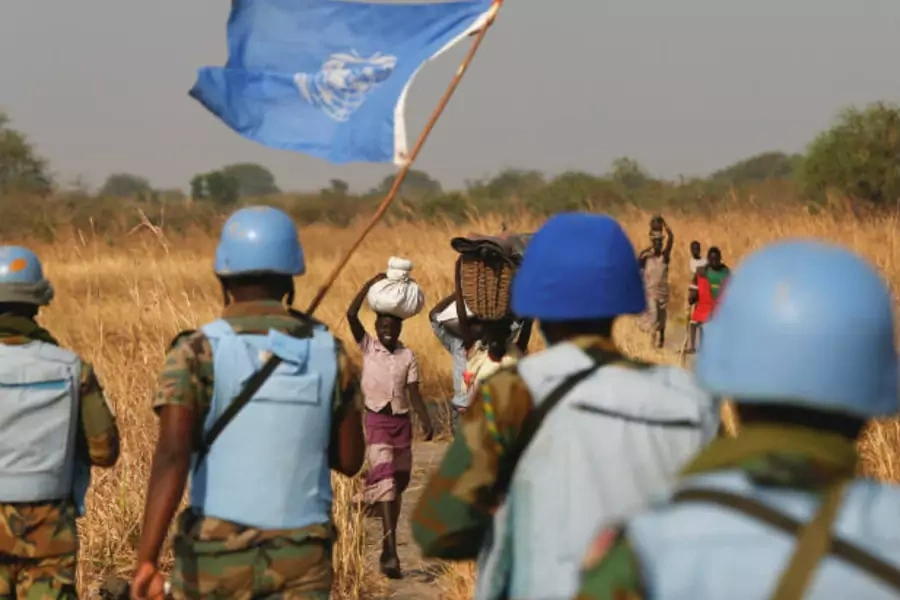Preventing Peacekeeper Abuse Through Equal Opportunity Peacekeeping

More on:
Voices from the Field features contributions from scholars and practitioners highlighting new research, thinking, and approaches to development challenges. This article is authored by Sabrina Karim, an assistant professor of government at Cornell University and U.S. Foreign Policy and International Security Fellow at Dartmouth College, and Kyle Beardsley, an associate professor of political science at Duke University.
Persistent allegations of sexual abuse and exploitation by United Nations peacekeepers threaten to delegitimize peacekeeping operations around the world. This month, UN Secretary General António Guterres called for “a new approach” to prevent sexual exploitation and abuse by United Nations peacekeepers. Previous Secretaries General have attempted to fix the problem, but have not been successful.
In our recent book, Equal Opportunity Peacekeeping, we suggest that any fix to this problem must address the broader gender inequalities within missions. Missions will be much more effective overall, including in the prevention of sexual exploitation and abuse, when they address gender inequalities in peacekeeping missions. One of our major findings is that when missions consist of personnel from member states with better records on gender equality, sexual exploitation and abuse allegations are fewer. This points to the larger culture of gender inequalities in missions as a major culprit in sexual exploitation and abuse.
One suggested route to reduce sexual exploitation and abuse has been to emphasize increases in the proportions of female peacekeepers in missions. We find this solution problematic. For one, the focus is not on changing the culture of peacekeeping missions, but rather on bringing women into missions in which they have little power. Women in peacekeeping missions face rampant discrimination, are confined to particular gendered roles, and their participation is thwarted by “old boys networks” that prevent them from having influence within missions. Moreover, female peacekeepers are less likely to be deployed to dangerous missions—ones where there are high levels of wartime sexual violence, low GDP, and high levels of battle-related fatalities. If female peacekeepers are excluded from these missions, they will not be able to affect peacekeeping engagements with the most vulnerable populations. And, within missions, they are restricted to certain spaces, often unable to help local women. Indeed, the problems of discrimination against women and the relegation of women to safe spaces are major topics in our book. Moreover, our research indicates that female peacekeepers suffer from harassment as well as sexual exploitation and abuse. Thus, the expectation that female peacekeepers can solve the problem of sexual exploitation and abuse is unrealistic given that they, themselves, face many barriers that prevent them from being able to make any meaningful change in missions.
Instead, we argue that reforms that target the culture of peacekeeping missions are better suited to solve the problem of sexual exploitation and abuse. We propose an alternative model of peacekeeping—equal opportunity peacekeeping. This includes five areas where large normative shifts are needed.
Leadership: No change is possible without strong leadership. We suggest that leaders for missions (Special Representatives to the Secretary General, Force Commanders and Police Commissioners) be selected with an eye toward gender equality.
Recruitment standards: We suggest that the types of recruits for peacekeeping missions can go a long way to improve effectiveness. Standards should be based off of qualities of which both men and women excel, as well as standards that incorporate beliefs about gender equality.
Promotion/demotion: Promotions within missions (such as lucrative placements or medals) can be awarded based off of performance on gender equality. Punishment can also be based on such standards. As a step forward, the UN has begun to name and shame contributing countries whose personnel receive allegations.
Role models, mentors, and networks: One way to improve women’s ability to gain access is to provide them with role models and mentors and to introduce them to different networks. This allows them to seek advice and gain information in a comfortable setting and to counter “old boys networks.”
Training and professionalization: We suggest that training and professionalization be tailored to instill an understanding of the link between gender equality and mission effectiveness. Within the mission, training and professionalization should be targeted for both men and women equally.
The culmination of these changes constitutes equal opportunity peacekeeping. Thus, if the UN is serious about change, it should consider adopting an equal opportunity peacekeeping model, a model that focuses on larger gender inequalities in missions as a way to ensure that the overall quality of peacekeeping missions improve. Only then might the reduction of sexual exploitation and abuse in peacekeeping missions be possible.
Learn more in Karim and Beardsley’s new book Equal Opportunity Peacekeeping, published by Oxford University Press in March 2017 >>
More on:
 Online Store
Online Store